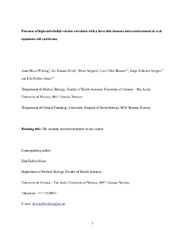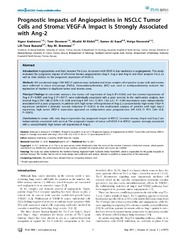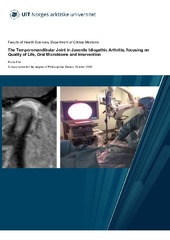Presence of high-endothelial venules correlates with a favorable immune microenvironment in oral squamous cell carsinoma
Permanent link
https://hdl.handle.net/10037/16559View/
(PDF)
(PDF)
(PDF)
(PDF)
(PDF)
(PDF)
(PDF)
(PDF)
(PDF)
Date
2017-10-31Type
Master thesisMastergradsoppgave
Author
Wirsing, Anna Maria; Ervik, Ida Korsnes; Seppola, Marit; Uhlin-Hansen, Lars; Steigen, Sonja Eriksson; Hadler-Olsen, ElinAbstract
Oral squamous cell carcinomas (OSCC) are associated with a poor prognosis, which may be partly due to functional impairment of the immune response. Lymphocyte recruitment to the tumor site is facilitated by high-endothelial venules (HEV), whereas expression of programmed-death ligand 1 (PD-L1) can impair T cell function. Thus, we hypothesize that these factors are important in shaping the immune response in OSCC. In the present study, we characterized the immune infiltrate in formalin-fixed, paraffin-embedded tumor samples from 75 OSCC patients. We used immunohistochemistry to determine the distribution of immune cell subsets, HEV and PD-L1, as well as quantitative real-time polymerase chain reaction to assess the expression of inflammatory cytokines and chemokines associated with lymphocyte trafficking. Finally, we calculated correlations between the presence of immune cell subsets, the gene expression patterns, HEV, PD-L1 and the clinicopathological parameters including patient survival. The presence of HEV correlated with increased number of CD3+ T cells and CD20+ B cells, higher levels of the chemokines CXCL12 and CCL21, and lower levels of CCL20, irrespective of the tumors’ T-stage. In univariate analysis, high levels of CD20+ B cells and CD68+ macrophages, positive HEV-status, and low T- and N-stages predicted longer patient survival. However, only the presence of HEV and a low T-stage were independent positive prognosticators. This indicates that HEV are important mediators and a convenient marker of an antitumor immune response in OSCC. Our findings support HEV as a potential immunomodulatory target in OSCC. PD-L1 staining in tumor cells correlated with lower T-stage, increased infiltration of CD4+ cells and higher expression of several inflammation-related cytokines. Thus, OSCC tumors rich in CD4+ cells may preferentially respond to PD-1/PD-L1 blockade therapy.
Publisher
UiT Norges arktiske universitetUiT The Arctic University of Norway
Metadata
Show full item recordCollections
Copyright 2017 The Author(s)
The following license file are associated with this item:
Except where otherwise noted, this item's license is described as Attribution-NonCommercial-ShareAlike 3.0 Unported (CC BY-NC-SA 3.0)
Related items
Showing items related by title, author, creator and subject.
-
Prognostic Impacts of Angiopoietins in NSCLC Tumor Cells and Stroma : VEGF-A Impact Is Strongly Associated with Ang-2
Andersen, Sigve; Dønnem, Tom; Al-Shibli, Khalid Ibrahim; Al-Saad, Samer; Stenvold, Helge; Busund, Lill-Tove; Bremnes, Roy M. (Journal article; Tidsskriftartikkel; Peer reviewed, 2011)Angiopoietins and their receptor Tie-2 are, in concert with VEGF-A, key mediators in angiogenesis. This study evaluates the prognostic impact of all known human angiopoietins (Ang-1, Ang-2 and Ang-4) and their receptor Tie-2, as well as their relation to the prognostic expression of VEGF-A. 335 unselected stage I-IIIA NSCLC-patients were included and tissue samples of respective tumor cells and ... -
The Temporomandibular Joint in Juvenile Idiopathic Arthritis, focusing on Quality of Life, Oral Microbiome and Intervention
Frid, Paula (Doctoral thesis; Doktorgradsavhandling, 2020-10-02)The temporomandibular joint (TMJ) is commonly involved in juvenile idiopathic arthritis (JIA), and may lead to impaired mouth opening, pain and facial growth disturbances. Asymptomatic TMJ arthritis may be diagnosed late in the disease course, thus management is challenging. The overall objectives of this thesis were to provide new knowledge on quality of life (QoL), the oral microbiome and interventions ... -
Humant papillomavirus : en litteraturstudie om HPV, dets relasjon til cancer og tiltak mot videre spredning av virus
Gabrielsen, Endre (Master thesis; Mastergradsoppgave, 2012-06-01)I 1983 oppdaget zur Hausen sammenhengen mellom Humant Papillomavirus (HPV) og livmorhalskreft. På denne tiden visste man ikke at det var HPV som var årsaken til at Helaceller kunne leve in vitro. Ny forskning relaterer HPV til en rekke andre cancertyper. En stor andel anal-, oropharyngeal-, penis-, vaginal-, og vulvacancer skyldes HPV. Det er også påvist HPV i tumorvev fra øsofagus, larynx, lunge, ...


 English
English norsk
norsk



